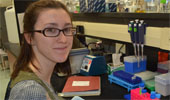The American Society of Plant Biologists Midwestern Section annual meeting in Columbus on March 22-23. Doctoral student Wen Dong and undergraduate student researchers Avery Tucker, Megan Moore, Sean Fenstemaker, and Tayler DeBrosse won awards for their presentations.
Avery E. Tucker, an Undergraduate Research Assistant in the Wyatt Lab, won Best Undergraduate Talk for a presentation on “Microarray Analysis of the GPS Treatment Reveals Novel Transcription Factors Involved in Gravitropic Signal Transduction.” His adviser is Dr. Sarah Wyatt, Professor of Environmental & Plant Biology.
Abstract: Avery Tucker, Kaiyu Shen, Zachary Abrams, and Sarah E. Wyatt. Department of Environmental and Plant Biology, Ohio University, Athens, OH 45701. Gravity is a fundamental stimulus that affects plant growth and development. A plant’s response to gravity can be separated into three phases: perception, signal transduction, and differential growth. The gravity persistent signal (GPS) treatment uses a cold treatment to isolate the events of signal transduction. After cold acclimation, Arabidopsis inflorescence stems were placed either upright (control) or on their sides (reoriented with respect to gravity) at 4°C for 1h, then returned to vertical at room temperature. Total mRNA was collected at 2, 4, 10, and 30min after reorientation in the cold. The mRNA was probed against the Agilent Arabidopsis gene expression array (4X44k) using a dual color platform, with 4 replicates per time point. Analysis of the raw data identified 349 genes that were either significantly up or down regulated as compared to the controls at the various time points: 8 genes at 2 min, 96 genes at 4 min, 190 genes at 10 min, and 65 genes at 30 min. Of these, 33 were transcription factors with the nine at 4 and 10min chosen for further analysis based on log-fold change and p-values. The expression profiles of
these genes were confirmed by qRT-PCR. Individual mutant lines for each were obtained from the Arabidopsis Biological Resource Center, bred for homozygosity and assessed for growth parameters, responses to gravity and GPS treatment. These genes may well play a fundamental role in gravitropic signal transduction. Partially supported by an Ohio University Student Enhancement Award to KS and NSF Award (#1147087) to SEW.
Megan Moore won Best Poster Presentation by an Undergraduate for her poster on “Characterization of gravity persistent signal (gps) 6 and Identification of GPS6 in Arabidopsis thaliana.”
Abstract: Moore, Megan, Hayden, Marilyn, Wyatt, Sarah E., Ohio University, Department of Environmental and Plant Biology, 22 Richland Ave., 315 Porter Hall, Athens, Ohio 45701. Gravity plays an essential role in plant growth and development. The gravity response pathway can be broken into three steps: gravity perception, signal transduction, and differential growth. Perception of gravity occurs through statolith sedimentation, which is transmitted into a biochemical signal that results in a differential distribution of auxin and corresponding growth response. While these steps are fairly well defined, the signaling events are less well understood. To isolate the signaling events, a cold treatment, designated the gravity persistent signal (GPS) treatment, was used to screen for mutants. gps6 was identified from a T-DNA tagged population of Arabidopsis thaliana. When subjected to the GPS treatment, the gps6 inflorescence stem bends out of the plane of gravity. Although PCR-based strategies have identified regions of the tag in gps6, they have not been successful in identifying the gene. Thus, deep sequencing of gDNA extracted from gps6 was used to identify candidate genes. Sequence reads were aligned to the WS wild-type reference genome, and 13 candidate genes identified. Arabidopsis lines containing T-DNA tags in those genes were obtained from the Arabidopsis Resource Center. Individual lines have been bred to homozygosity for the mutant and will be screened for the gps6 phenotype to determine which candidate gene is actually GPS6. Genetic transformation of that wild type gene into the gps6 mutant background will confirm the identification of GPS6. Identification of GPS6 will provide additional information in defining the signal transduction pathway of plant gravitropism. This work was partially supported by NSF #1147087 to SEW.
Sean M. Fenstemaker ’13, an Applied Plant Ecology and Bioinformatics research assistant in the Wyatt Lab, received Honorable Mention for an Undergraduate Talk on “A Comprehensive Approach to Characterizing and Cloning the Gravity Persistence Signal (GPS) Mutants.” His adviser is Dr. Sarah Wyatt.
Abstract: Fenstemaker Sean and Wyatt Sarah. Department of Environmental and Plant Biology, Ohio University,
Athens, OH 45701. The gravity persistence signal (GPS) response isolates the signal transduction phase of the gravitropic response pathway. The GPS mutants were identified from the T-DNA tagged population developed by Ken Feldmann in the mid-1990s. The GPS3 mutant is characterized by an “over achiever” response, the GPS2 mutant bends the “wrong way”, and GPS6 bends out of the plane of gravistimulation when returned to room temperature after being reoriented at 4°C. Although PCR based cloning methods were successful in cloning GPS1 and GPS4, they have not been productive in identifying the flanking regions of the TDNA insertions in GPS3, GPS2, and GPS6. Therefore, deep sequencing was used to identify genes defective in GPS2, GPS3, and GPS6. The genomes of the mutants were sequenced and assembled against the WS reference sequence, and a BLAST database was constructed using the unaligned fragments. That database was screened using 50 bp fragments of the T-DNA tag. Sequences that aligned with the tag were selected, and the regions flanking the tag used to identify potential genes of interest. For GPS2, one candidate gene was found. For GPS3, 3 candidates were identified, and for GPS6, 14 genes contained a piece of the tag. These genes were sequenced in the respective mutant background to confirm presence of the tag, and SALK insertion lines were obtained from the Arabidopsis Biological Resource Center that contain mutations in the remaining genes to test for GPS phenotype. Identification of GPS2, GPS3 and GPS6 will contribute to the gravitropic signal transduction pathway. Research partially supported by NSF Award #1147087 to SEW.
Tayler A. DeBrosse, an Environmental and Plant Biology student, received Honorable Mention for an Undergraduate Talk on “Arabinogalactan-Protein and Cell Wall-Associated Receptor Kinase Interactions: Cellular Signaling of Root Growth in Arabidopsis.” Her adviser is Dr. Allan Showalter.
Abstract: DeBrosse, Tayler, Poirier, Emily, Basu, Debarati, and Showalter, Alan. Department of Environmental and Plant Biology, Ohio University, Athens, OH 45701. Arabinogalactan-proteins (AGPs) are ubiquitous plant cell wall proteins expressed in virtually all plant cells and reside mainly at the plasma membrane-cell wall interface and in plant exudates. Knock-out mutants of FLA4 (also known as SOS5), a fasciclin-like arabinogalactan-protein, in the presence of elevated salt displayed abnormal radial swelling of root tips. AGPs are known to be involved in salt stress but their precise function and mode of action is unclear. FLA4 is anchored to the plasma membrane by a glycosylphosphatidylinositol (GPI) anchor, and rest of the protein resides in the cell wall, making it ideally positioned to transmit information between the cell wall and the cytoplasm. A double mutant encoding two cell wall associated receptor-like kinases (FEI1 and FEI2) also displayed an identical phenotype to fla4 (sos5) under similar conditions. In addition, a double mutant encoding two
galactosyltransferases (GALT2 and GALT5) responsible for glycosylation of AGPs displayed an identical phenotype to fla4 and fei1 fei2 mutants. Since the galt2 galt5 double mutant has a reduced amount of glycosylated root AGPs, it is hypothesized that glycosylation of FLA4 is required for it to function in the FLA4/FEI1-FEI2 pathway to signal normal root growth. In order to begin to test this hypothesis, a genetic cross was performed between fei1 fei2 sos5 triple mutants and galt2 galt5 double to determine whether all these respective gene products are indeed interacting in a single, linear pathway. Screening of homozygous fei1 fei2 sos5 galt2 galt5 mutants is currently underway.
Wen Dong, a graduate student in Chemistry & Biochemistry, received third place in Best Talk by a Graduate Student for an oral presentation on “In vitro Characterization of Recombinant Extensin peroxidase from Lycopersicon esculentum.” His advisers are Dr. Michael Held, Assistant Professor, and Dr. Marcia Kieliszewski, Professor of Chemistry & Biochemistry.
Abstract: Dong, Wen, Department of Chemistry and Biochemistry, Ohio University, Athens, Ohio 45701, Kieliszewski, Marcia, Department of Chemistry and Biochemistry, Ohio University, Athens, Ohio 45701, Held, Michael, Department of Chemistry and Biochemistry, Ohio University, Athens, Ohio 45701. Growth regulation and early plant defense response involve the insolubilization of hydroxyproline-rich glycoproteins (HRGPs), such as extensin in the primary cell wall. In tomato (Lycopersicon esculentum), insolublization occurs by the formation of tyrosyl-crosslinks catalyzed specifically by the pI 4.6 extensin peroxidase (EP). To date, neither the gene encoding EP nor the protein itself has been identified. Here we have identified tomato EP candidates using both proteomic and bioinformatic approaches. Bioinformatics of the tomato genome yielded 8 EP candidates that contained a putative signal sequence and had a predicted pI near 4.6. Biochemical fractionation of tomato culture media followed by proteomic detection further refined our list of EP candidates to three and has identified a lead EP candidate. To test for EP activity among these candidates, we have cloned EP candidate genes from tomato cDNA into bacterial expression vectors. Our lead EP candidate has been expressed in E. coli, fractionated from inclusion bodies, and folded in vitro. The peroxidase activity of folded recombinant protein (rEP) has been assayed and quantified by ABTS (2,2′-azino-bis(3-ethylbenzothiazoline-6-sulphonic acid) assay. The ability of rEP to crosslink authentic tomato P1 type extensin substrate in vitro is currently being examined and preliminary data suggest rEP does indeed possess extensin peroxidase activity. Together our data indicate that we have identified the pI4.6 tomato EP.
Debarati Basu, an Environmental and Plant Biology Ph.D. student in the Molecular and Cellular Biology program, gave an oral presentation on “Two Hydroxyproline Galactosyltransferases, GALT5 and GALT2, are Essential for Arabinogalactan-Protein Glycosylation and Development in Arabidopsis.” Her adviser is Dr. Allan Showalter, Professor of Environmental & Plant Biology.
Abstract: Basu, Debarati, Environmental and Plant Biology, Ohio University, Athens, Ohio-45701, Wang, Wuda, Environmental and Plant Biology, Ohio University, Athens, Ohio-45701, Showalter, Allan M., Environmental and Plant Biology, Ohio University, Athens, Ohio-45701. AGPs are a class of highly glycosylated cell wall glycoproteins, virtually present in all plant cells and in all plant species, from algae to angiosperms. They have diverse biological roles that span plant embryogenesis through multiple stages of plant development. Given that the sugar side chains typically account for more than 90% of the molecular mass of AGPs, they are likely to define the interactive surface of the molecule and hence its function. Considerable progress in recent years have led to the identification of two fucosyltransferases genes (FUT4 and FUT6) members of CAZy GT-family-37, two galactosyltransferase genes (GALT2 and GALT31A) members of GT-family-31 and two gluronosyltransferase belonging to GT-family-14 that encodes glycosyltransferases specific for biosynthesis of AGPs. Despite information gained in recent years with respect to biosynthesis of AGPs, their precise physiological functions have not yet been elucidated. Here we have characterized At1g74800, named AtGALT5, a galactosyltransferase belonging to GT-family-31 that catalyzes addition of galactose (Gal) to hydroxyproline (Hyp) in AGP protein backbones. Detergent permealised microsomes obtained from Pichia expressing AtGALT5 specifically catalyzed incorporation of [14C] Gal from UDP-[14C] Gal to Hyp in two model substrate acceptors, chemically synthesized [AO]7 and HFdeglycosylated d[AO]51. These substrate acceptors have peptide sequences that mimic AGP backbones, consisting of non-contiguous Hyp residues, such as [Ala-Hyp] repetitive units. Furthermore, AtGALT5 also shares similar biochemical properties with that of AtGALT2 by using only UDP-Gal as the substrate donor and requiring Mg2+ or Mn2+ for high activity. But unlike AtGALT2, which is localized in both Endoplasmic reticulum and Golgi vesicles, confocal microscopic analysis of fluorescently tagged AtGALT5 in tobacco epidermal cells indicated that AtGALT5 is only localized in the Golgi vesicles. Additional support that AtGALT5 encodes an AGP-Hyp-GALT was provided by two allelic AtGALT5 knockout mutants (galt5-1 and galt5-2), which demonstrated significantly lower Hyp-GALT activities and reductions in X-Gal Yariv-precipitated AGPs compared to wild type plants. The physiological functions of galactosyltion of AGPs were also examined by analyzing both single (galt2-1 galt2-2, galt5- 1, galt5-2) and double knockout mutants (galt2-1/galt5-1) and showed that both GALTs are essential for tip growth and also involved in root development in response to salt stress. Specifically, these mutants demonstrated reproducible mutant phenotypes (i.e., delayed germination, inhibition of root growth, and root tip swelling in the presence of NaCl and mannitol). Moreover, galt2/galt5 double mutants displayed more severe versions of all these biochemical and physiological phenotypes, indicating functional redundancy. In summary, these findings advance our understanding of the biosynthesis and function of AGPs in plants.
Adam Cook, an undergraduate student in Environmental and Plant Biology, and Anna Luisa Decarvalo-Brito, a visiting undergraduate from Brazil, gave a poster presentation on “Characterization and cloning of the GPS3 & GPS2 gene of Arabidopsis.” Sean Fenstemaker also worked on this poster.
Abstract: Fenstemaker Sean, Decarvalo-Brito Anna Luisa, Cook Adam, Wyatt Sarah, Department of Environmental and Plant Biology, 315 Porter Hall, Ohio University, Athens, Ohio 45701, USA. The positioning of plant organs is dependent on environmental signals such as light, gravity, and water. Simplistically, the response to gravity can be defined in three steps: perception of gravity, signal transduction, and the differential growth response. A cold treatment, the gravity persistence signal (GPS) treatment, was used to isolate the signal transduction phase and screen for mutants defective in that phase. The gps mutants were identified from a T-DNA tagged population. But PCR-based cloning strategies utilizing the T-DNA sequence were not productive in identifying the genes defective in gps3 and gps2. Therefore, we developed a strategy using Next-Generation Sequencing to identify candidate genes responsible for the respective mutant phenotypes. For GPS2, one candidate gene was found; for GPS3, three candidates were identified. SALK insertion lines for the candidate genes were obtained from the Arabidopsis Biological Resource Center. Additionally, TAIL PCR identified a 500 bp region of the TDNA tag flanking Auxin Response Factor 23. Because a SALK insertion line is not available, we will use an antisense construct of the gene to create a knockout for ARF23. All of these mutant lines will be screened for the gps2 or 3 phenotypes as appropriate. If one of the mutants presents with the gps phenotype, the WT allele of the corresponding gene will be transformed into the mutant background to confirm identity of the gene. Identification of GPS2 and GPS3 will contribute to our knowledge of the gravitropic signal transduction pathway. Research partially supported by NSF Award #1147087 to SEW.
Marilyn Hayden ’13, an M.S. student in Molecular and Cellular Biology and Lab Manager in the Wyatt Lab, and Proma Basu, an M.S. student in the Molecular and Cellular Biology program, presented a poster on “Preparing for a Spaceflight: Definition Phase.” She earned a B.S. in Biology, a minor in Computer Sciences and a Bioinformatics Certificate in 2013.
Abstract: Hayden, Marilyn, Basu, Proma, Wyatt, Sarah, 508 Porter Hall, Department of Environmental and Plant Biology, Ohio University, Athens, Ohio 45701, USA. The plant stress response is rapid and quantifiable as it manifests through a change in the proteome. The spaceflight environment provides a unique environmental stress for plants: Microgravity. Although plant experiments have flown regularly throughout the last 60 years, recent studies have focused on transcriptional and genomic changes between plants in the spaceflight environment and ground controls. Because these changes result in differential expression of proteins, proteomic analysis is actually a more direct measurement of the plant’s response to microgravity. However, to ‘fly’ an experiment is a monumental project. The experiment can’t fail and then just be redone. Therefore, spaceflight research is organized into phases to ensure accuracy and specificity of the experimental design: the Definition Phase, the Scientific Verification Test (SVT) and the Payload Verification Test (PVT). The Definition Phase of spaceflight research requires determination of specific parameters of the experimental design. For the proteomics analysis of Arabidopsis seedlings, wild-type Columbia seeds will be flown. For the Definition Phase two questions needed to be addressed: 1) the optimum number of Arabidopsis Columbia wild-type seeds per plate to allow sufficient tissue for proteomics analysis and minimize ethylene effects, and 2) the amount of time the plated seeds can stay in cold stratification without germination, in case of a launch delay. Next, SVT and PVT must be successfully completed for the experiment to be slated for spaceflight. Once these samples return from the International Space Station, the real work begins: RNAseq and proteomics analysis.
Megan Osika is currently working on a joint project with Wyatt and Dr. David Rosenthal, Assistant Professor of Environmental & Plant Biology. She gave a poster presentation on “Can modifying SBPase gene expression alter photosynthetic efficiency in Arabidopsis?”
Abstract: Osika Megan, Wyatt Sarah E., Rosenthal David M., Environmental and Plant Biology, Ohio University, Athens, OH 45701. Photosynthesis is an essential plant function that allows the plant to produce sugars, by fixing CO2 and releases oxygen as a byproduct. Currently plant photosynthesis is limited by the availability of atmospheric CO2 for the plant to assimilate, therefore as our atmosphere’s CO2 concentration [CO2] increases, plants that use C3 photosynthesis will be stimulated. This is true because the carboxylating enzyme Ribulose Bisphosphate Carboxylase/Oxygenase (Rubisco) is not saturated at current ambient [CO2]. Rubisco catalyzes the reaction between Ribulose-1,5-bisphosphate (RuBP) and CO2. In a more CO2 rich environment, Rubisco will be saturated and photosynthesis will limited by the capacity to regenerate RuBP. Further increases in photosynthesis at elevated [CO2] could be achieved by increasing RuBP regeneration, and the enzymes that help regulate it. The enzyme sedoheptulose 1,7 bisphosphatase (SBPase) is directly involved in RuBP regeneration. Thus, overexpressing the SBPase gene should stimulate carbon assimilation. The SBPase gene from Arabidopsis thaliana has been cloned and will be transformed back into Arabidopsis, using Agrobacterium mediated transformation. Both sense and antisense variants will be introduced under control of the 35S promoter to overexpress and knock out the SBPase gene. Plants will then be evaluated for photosynthetic efficiency. Antisense plants are expected to have significantly lower levels of CO2 assimilation, while those overexpressing the SBPase enzyme are expected to increase CO2 assimilation levels. These more efficient plants may provide possibilities for reducing fertilizer inputs because a photosynthetically efficient plant should produce more biomass with less fertilizer than a wildtype plant.
Emily Poirier submitted an abstract on “Physiological and biochemical characterization of genetic mutants for a galactosyltransferase (GALT3) involved in arabinogalactan-protein glycosylation in Arabidopsis thaliana.”
Abstract: Poirier, Emily, Debrosse, Tayler, Basu, Debarati, Liang, Yan, Showalter, Allen M., Department of Environmental and Plant Biology, Ohio University, Athens, OH 45701.Arabinogalactan-proteins (AGPs) are a class of highly glycosylated cell wall proteins implicated to function in plant growth, development and signaling. AGPs are found in plasma membranes, cell walls and plant secretions. A bioinformatics approach was adopted to identify putative galactosyltransferases (GALTs) in Arabidopsis thaliana responsible for the initial steps of AGP glycosylation. Based on sequence alignments and domain searches with previously characterized mammalian β-(1,3)- glycosyltransferases, six putative Arabidopsis GALT genes belonging to the GT-31 family in the Carbohydrate-Active Enzymes (CAZy) database were selected. To characterize one of the six GALTs, namely GALT3 (At3g06440), a reverse genetic approach was adopted. Two allelic galt3 mutants (galt3-1 and galt3-2) were obtained, and homozygous mutant lines were generated. Elimination of GALT3 transcripts in both allelic mutants was confirmed by RT-PCR. Knock-out galt3 mutants did not show any obvious phenotypic differences compared to wild type Arabidopsis Col-0 plants (WT). Biochemical and conditional physiological analysis of the mutants, however, revealed some significant differences. Specifically, both allelic mutants had a significant reduction in X-Gal Yariv-precipitated AGPs and showed reduced inhibition of root growth in presence of 50μM X-Gal Yariv compared to WT plants. In addition, both allelic mutants demonstrated hypersensitivity towards salt stress in a root bending assay. Confocal microscopic analysis of fluorescently-tagged GALT3 expressed in tobacco epidermal cells indicated GALT3 is localized in Golgi vesicles, a known site for AGP glycosylation. Heterologous expression of GALT3 in bacterial, yeast and tobacco cells is currently underway to verify AGP galactosyltransferase activity in an in vitro enzyme assay.

























Comments